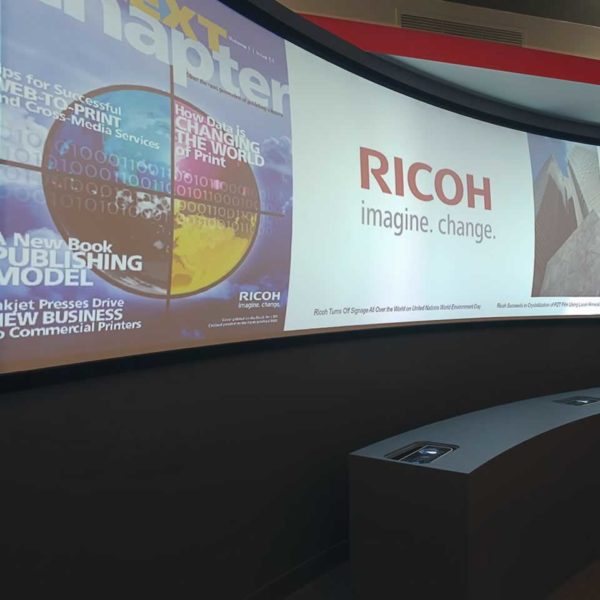At InfoComm 2014, many companies showed new products that make deployment of digital signage easier and more flexible for schools

At InfoComm 2014, North America’s largest audio-visual trade show, there were several innovations in digital signage on display—and many of these new products could make it easier for schools and other organizations to deploy digital signage in more creative, flexible, and cost-effective ways.
Here are three key developments we noted in digital signage at the conference.
Portability
Having the flexibility to move digital signage around a building or campus—setting it up for special events, for example, and then taking it down for use in other locations—could help schools get more bang for their buck, and this kind of portability was an important feature of some of the new digital signage products introduced at InfoComm.
For instance, Ricoh unveiled a projector-based mobile digital signage solution that includes either two or three ultra short-throw projectors, a Lenovo computer loaded with edge-blending software, and all the cabling and other accessories needed to set up the system.
“Traditional digital signage solutions constrain you to the size of the display, its rectangular shape, a flat screen, and the place you affixed it to the wall,” said Matt Sakauchi, vice president of technology marketing for Ricoh Americas Corp. “For those who need more flexibility—big, bold, shape-shiftable images and the ability to move them around at will—the Ricoh Digital Signage Solution is a perfect way to transform and share information and inspire audiences. It comes with everything you need, fully integrated and ready to switch on.”
The two-projector version, called the RDS2 system, can create a 12-foot wide display. The three-projector version, the RDS3, can create an 18-foot wide display.
Peerless-AV showed a series of portable video wall carts. These modular, adjustable, flat-screen mounting racks can accommodate two-by-two, two-by-three, or three-by-three screens of up to 60 inches each. The racks are built on wheels, so you can move the video wall wherever you want to deploy it within a building.
(Next page: Two more key developments in digital signage technology)
Creative form factors
BenQ showed new products designed to make digital signage deployment more flexible, including smaller, narrower flat-screen panels with a 16-by-3 aspect ratio instead of 16-by-9. Available in 28-inch and 33-inch sizes, these screens—available for about $1,000 apiece—can be stacked to create digital signage in virtually any size, said Bob Wudeck, associate vice president for BenQ.
“We’re trying to put digital signage in areas you wouldn’t expect, in ways you wouldn’t expect,” Wudeck said.
BenQ also unveiled a 55-inch, dual-sided standing display, barely wider than a thumb, on which you could show one message for people entering a room or building and a different message for those who are leaving. This dual-sided display sells for around $5,000.
Projector makers like Ricoh and Epson, meanwhile, demonstrated how projectors could be used to create dynamic digital signage on curved or irregular surfaces, such as cubes or other shapes.
Another creative form factor on display at InfoComm was transparent digital signage, shown by companies such as LG and Planar. These LCD displays let light through, so you can see objects behind them—and they could have interesting applications for display cases in school hallways or campus museums, for instance.
The IP-based audio company Barix showed a new product called Audio Point, which enables schools to set up what Barix CEO Andy Stadheim called “audio signage.”
The product consists of a router and two bridges for creating audio channels that can stream audio on demand to a user’s device of choice. You can synchronize this audio stream with video being shown on digital signage, for instance—or you could provide just an audio video feed for assisted listening, tours, or other applications.
Audio streams can be single- or multi-channel, allowing schools to deliver streams in multiple languages. A demo kit costs between $1,500 and $2,000.
(Next page: New products that make digital signage easier and more cost-effective to deploy)
Easier use
Samsung promoted its “smart signage” products at InfoComm, which embed the chipset for programming digital signage into the displays themselves—meaning you don’t need a separate video player or server to run the signage.
Samsung says these smart displays can reduce the cost of deploying digital signage by as much as 30 percent. They come with a snap-on bezel kit, so you can change the look of the displays to match your school’s brand as well.
Tightrope Media Systems, which makes software that programs digital signage, has partnered with BrightSign, a company that makes digital signage media players. The partnership will make large-scale deployments of digital signage using the two companies’ systems more affordable, said Eric Henry, signage solutions lead for Tightrope.
Tightrope has integrated social media into its software more broadly as well, in ways that make it easier to display messages without having to log into the program separately.
For instance, you can set up digital signage to show messages containing certain social media hashtags on various screens—and every time someone with administrator privileges uses that hashtag with his or her Twitter or Instagram account, the message would display on these screens automatically.
Visix also introduced new software aimed at making it easier to create messages for digital signage. AxisTV Design includes a new user interface for the company’s AxisTV signage platform, modeled after familiar Microsoft Office designs to make it user-friendly.
AxisTV Design also includes easy-to-use widgets that users can drag and drop into the design space to create captivating content and layouts for their signage. These widgets include playlists, images, video, and more, Visix said—and intuitive tools such as guides and rulers help with the formatting of designs.
Black Box—which provides everything from digital signage players to cabling, mounts, switches, consulting, and installation—shared a “Roadmap to Digital Signage Success,” which includes an extensive checklist of questions to consider as you deploy digital signage. These questions are organized according to the “7 Key Elements of Digital Signage,” which are Design, Content, Connectivity, Operations, Software, Hardware, and Business.
For instance, under Design, the questions to consider include: What is the objective of your signage—to inform, entertain, or call people to action? Who are the intended viewers, and how many displays will be required?
Under Content, you should consider: Who will be responsible for the overall “look and feel” of content to make sure it reflects your school or district’s branding? Are there existing content resources you can draw from?
And under Operations, who will have administrator privileges to create and broadcast messages? What department ultimately will have ownership of the information—IT, communications, or someone else?
“Being able to understand and answer each of these questions will certainly help you on your journey to digital signage success,” Black Box says.
Follow Editorial Director Dennis Pierce on Twitter: @eSN_Dennis.
- Can technology help schools prevent AI-based cheating? - April 14, 2023
- How to ensure digital equity in online testing - July 6, 2022
- ‘Digital skills gap’ threatens innovation - May 30, 2022


